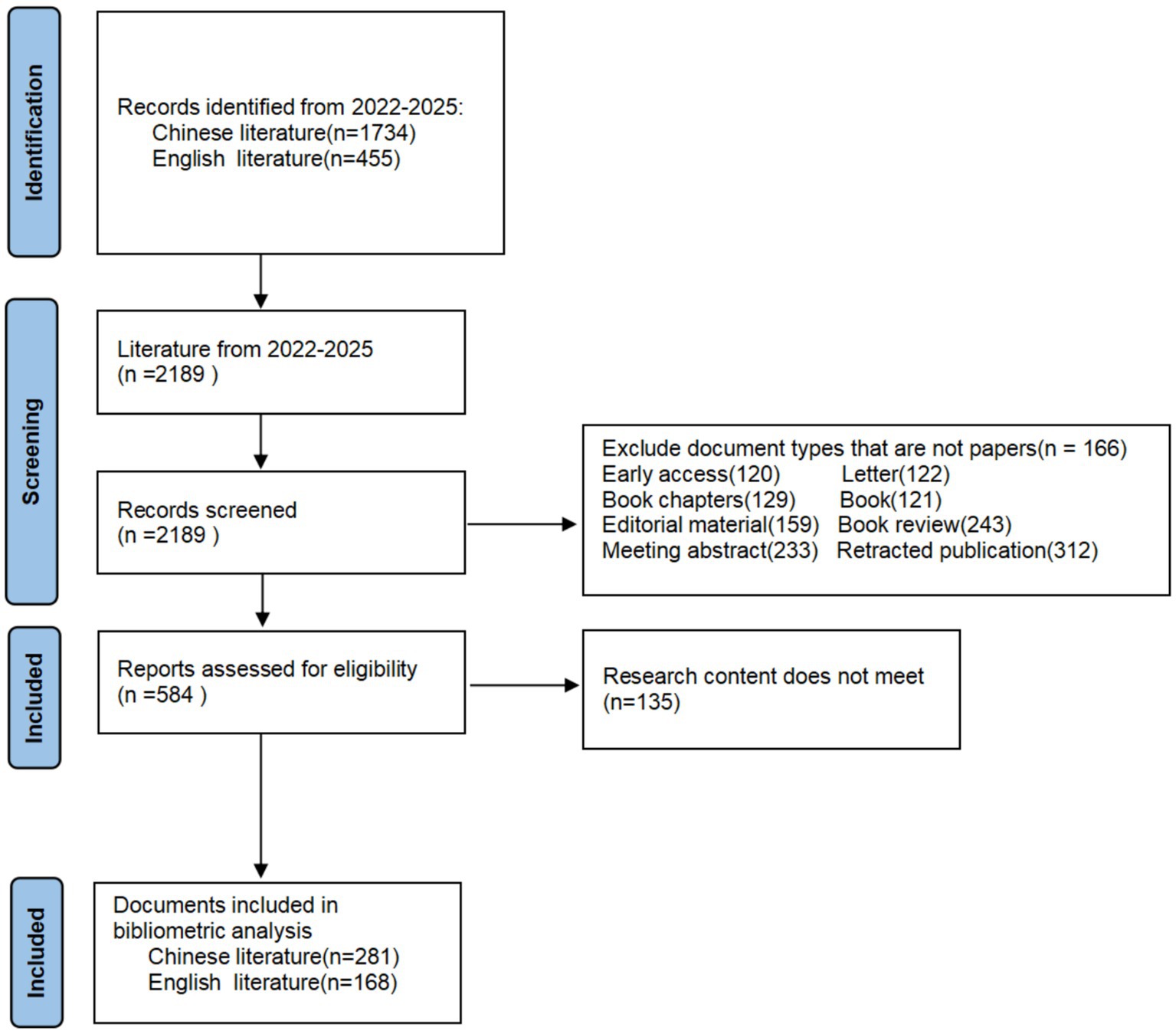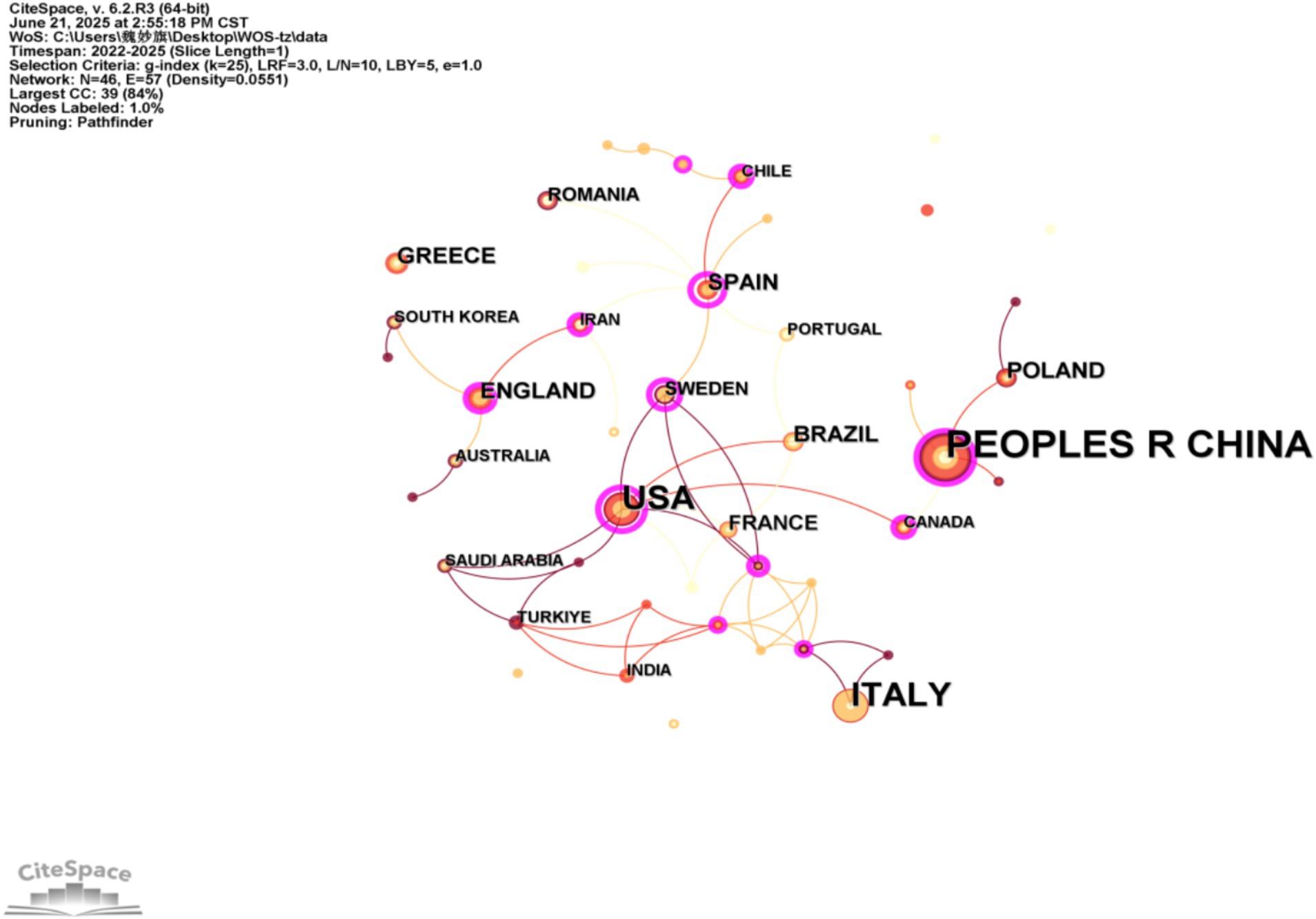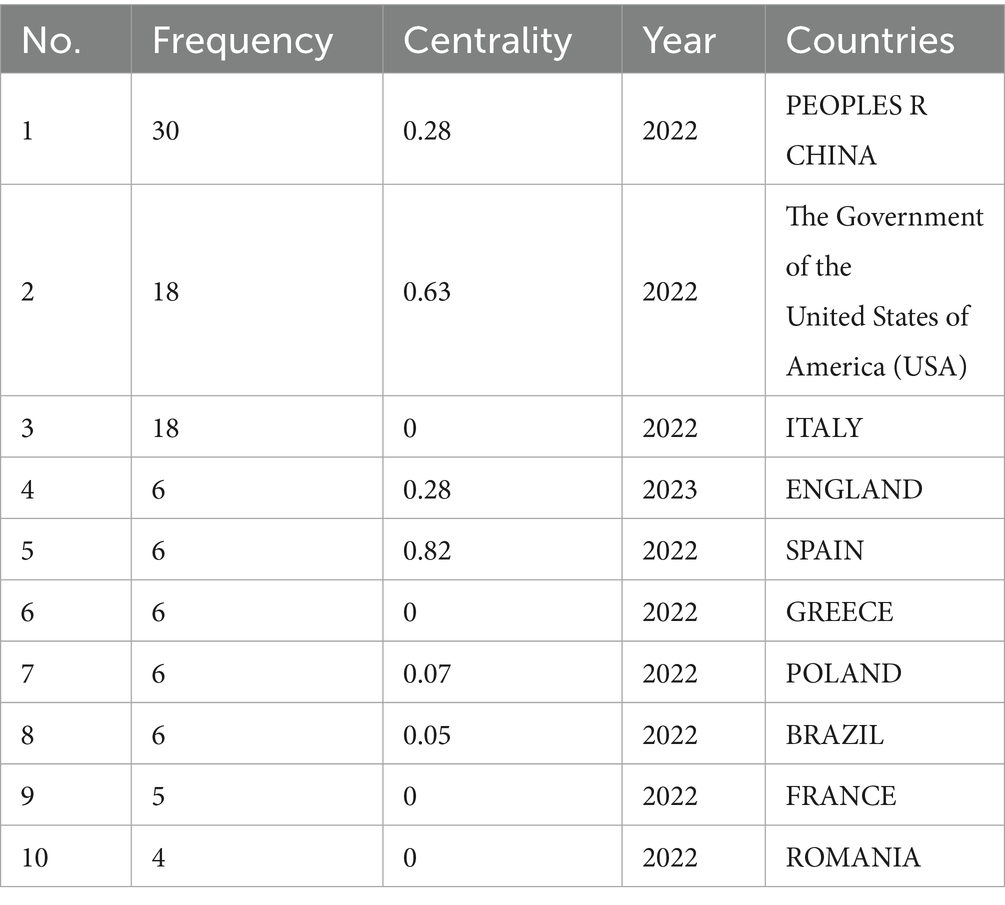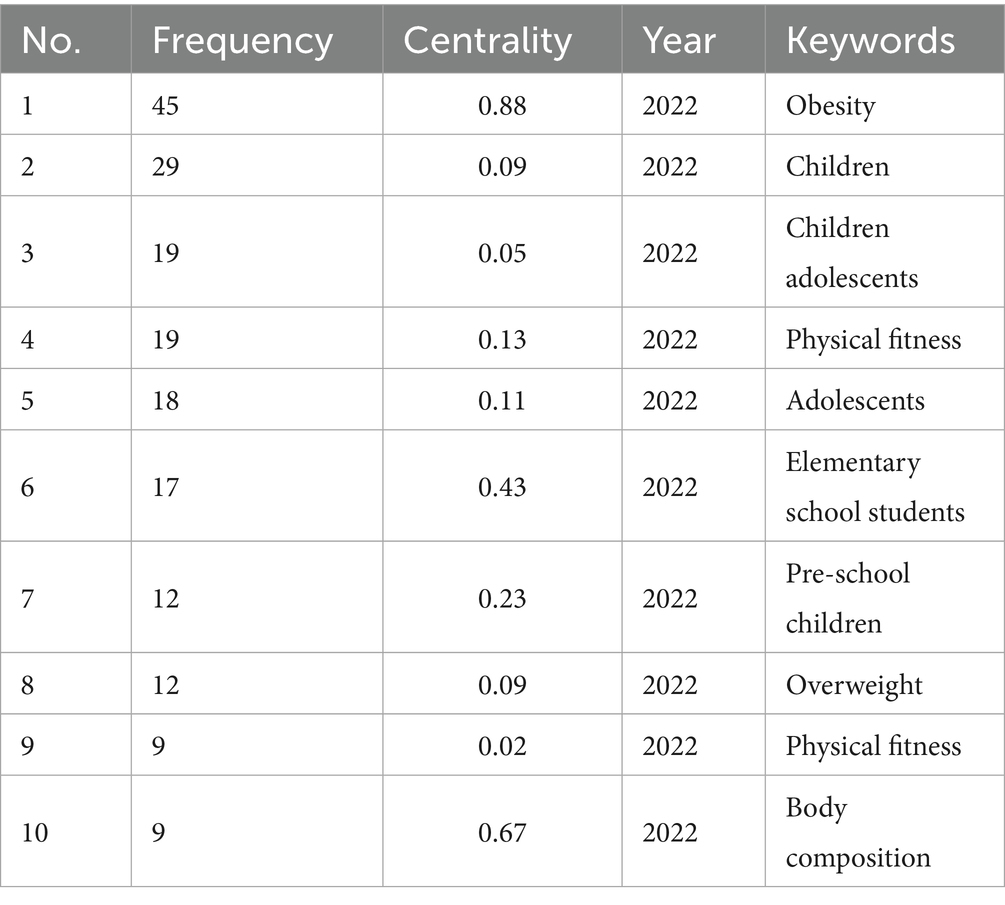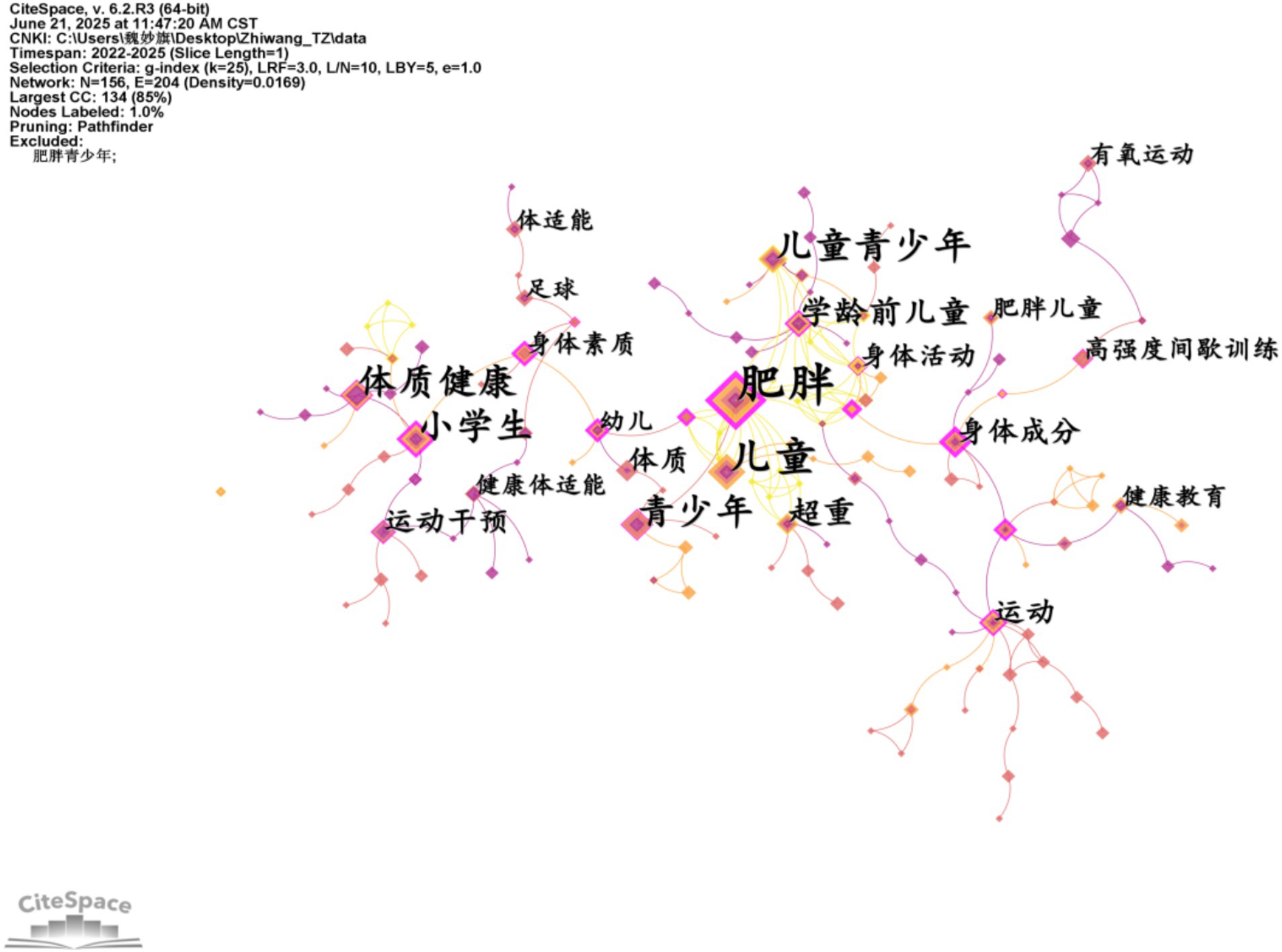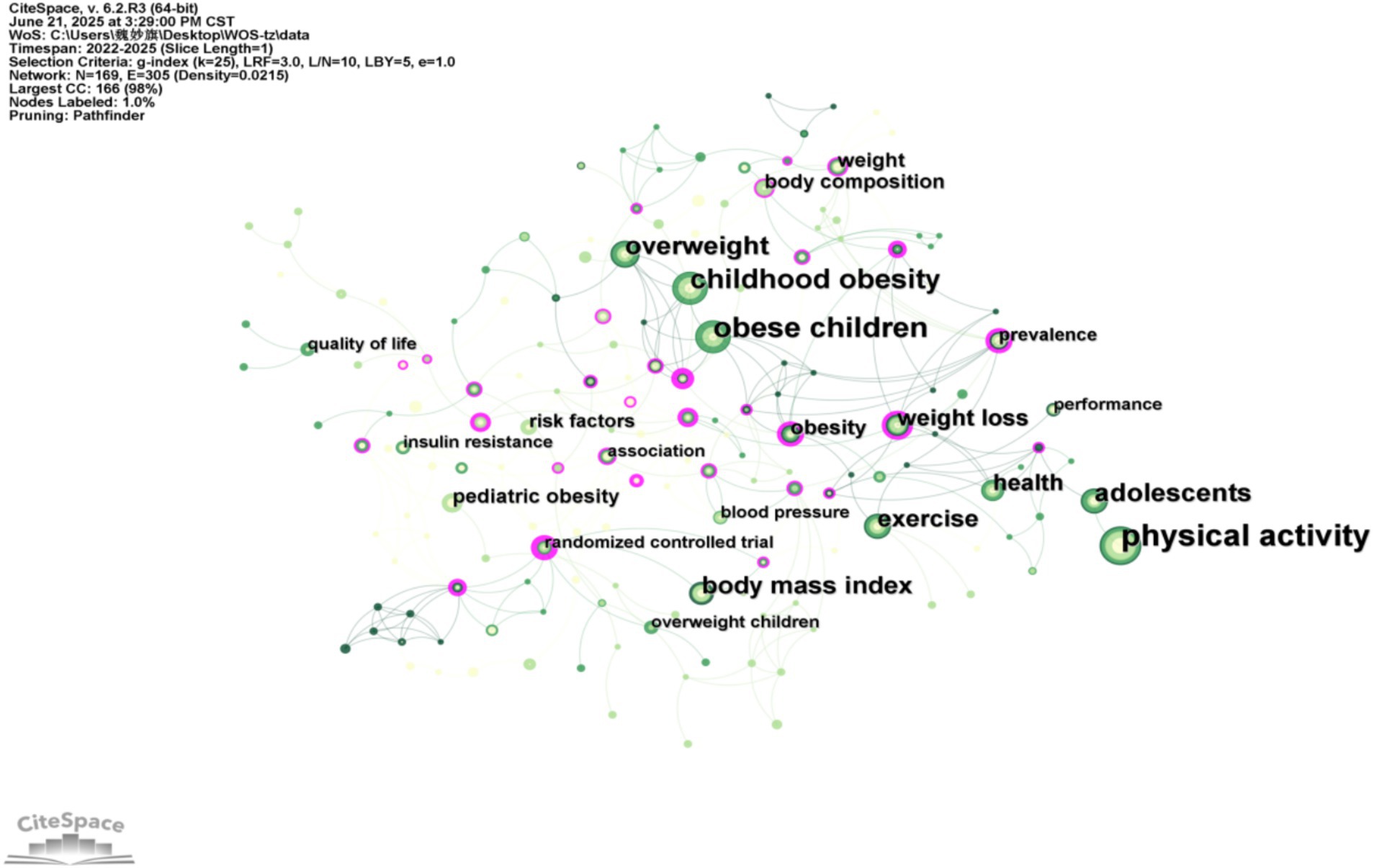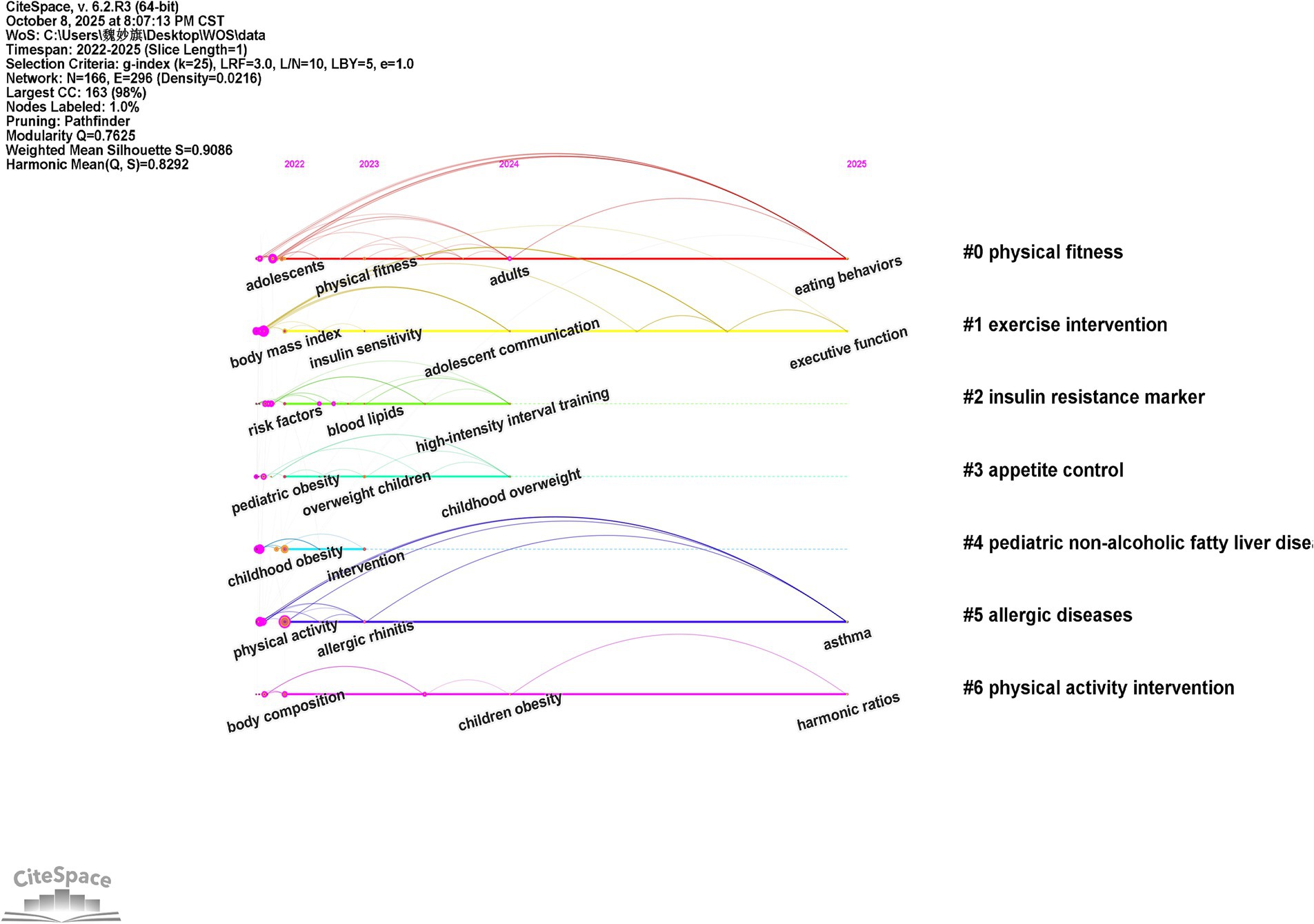- Huzhou Central Hospital, Affiliated Central Hospital of Huzhou University, Huzhou, China
Objective: This research aims to investigate the current research landscape, key focus areas, and emerging trends within the field of.
Methods: We conducted searches on the Wanfang Data Knowledge Service Platform, China National Knowledge Infrastructure (CNKI), Web of Science (WOS) and PubMed databases. Bibliometric analysis was performed using CiteSpace 6.2.R3 software. Analytical methods included annual publication volume, co-authorship network analysis between countries, keywords co-occurrence analysis, and cluster analysis.
Results: From January 1, 2022, to June 1, 2025, a total of 281 Chinese-language publications and 168 English-language publications were retrieved. China exhibited the highest publication output, followed by the largest number of publications in the world. China exhibited the highest publication output, followed by the United States and Italy. in current research, both domestically and internationally, centers on holistic lifestyle restructuring. This involves replacing unhealthy lifestyle patterns with structured health behavior interventions. This involves replacing unhealthy lifestyle patterns with structured health behavior interventions, such as personalized exercise prescriptions and precision nutrition plans. Cluster analysis identified 7 distinct research hotspots within the field. Citespace keyword timeline analysis shows that intervention studies in this field have consistently emphasized placing the participation of children and their families at the core.
Conclusion: By conducting an in-depth exploration of the definition, characteristics, and influencing factors related to childhood weight management, alongside investigating intervention methods and measures, this by conducting an in-depth exploration of the definition characteristics, and influencing factors related to childhood weight management, alongside investigating intervention methods and measures, this research advocates for a paradigm shift. The field should transition from fragmented approaches toward standardized, multidisciplinary collaborative models for childhood weight management.
1 Introduction
In recent decades, the synergistic effects of global economic development and dietary habit transformations have contributed to a dramatic increase in childhood obesity prevalence worldwide, emerging as a critical public health challenge (1). The World Obesity Federation’s 2019 Childhood Obesity Atlas Report projects that approximately 254 million children and adolescents aged 5–19 years will be classified as obese globally by 2030 (2). The COVID-19 pandemic has further exacerbated this concerning trend through multiple pathways. Research indicates that pandemic control measures have led to significant behavioral changes, including increased food consumption with a shift toward less healthy options (e.g., processed meats and sugar-sweetened beverages), coupled with marked reductions in physical activity levels among children (3, 4). Notably, screen time among children has increased by 67% during this period, with the most pronounced increase (1.4 h per day) observed in children aged 6–10 years (5). Epidemiological evidence suggests that each additional daily hour of screen exposure may elevate obesity risk by approximately 2% (6).
Currently, there is a scarcity of systematic review studies on children’s weight management in China, with existing literature often lacking objective and quantitative analysis. CiteSpace, a widely recognized bibliometric analysis tool (7), has been extensively employed in review articles both domestically and internationally, demonstrating high reliability. Therefore, there is a pressing need for a more intuitive and bibliometrics-driven approach to systematically summarize research in this field, aiming to clarify the current research landscape, key focus areas, and emerging trends in children’s weight management globally. Such an analysis will provide valuable insights to inform the development of weight management interventions and guide clinical practice in China.
2 Data sources and research methods
2.1 Literature retrieval
2.1.1 Search strategy
We conducted comprehensive literature searches in the Wanfang Database, China National Knowledge Infrastructure (CNKI), Web of Science (WOS), and PubMed databases to identify published research related to children’s weight management from January 1, 2022, to June 1, 2025. The Chinese search strategy employed was: (SU = ‘children’ + ‘obese children’ + ‘overweight children’) AND (SU = ‘weight’ OR ‘weight gain’ + ‘weight increase’ + ‘weight change’) AND (SU = ‘management’ + ‘intervention’ + ‘control’) AND (SU = ‘exercise’ OR ‘diet’). The English search strategy was: [TS = (“overweight children” OR “obese children”)] AND TS = (weight OR “weight gain” OR “body weight”) AND TS = (exercise* OR movement OR athletic OR sport* OR “physical activit*”) AND TS = (assessment OR management OR intervention OR control OR monitoring OR maintain). We limited the search to articles and review papers published in English.
2.1.2 Inclusion criteria
(1) The literature is publicly published; (2) Patients are ≥18 years old; (3) Weight is one of the outcome indicators.
2.1.3 Exclusion criteria
(1) The literature lacks the fields required for analysis; (2) The literature is a conference paper, meta-analysis, news article, patent, or scientific achievement; (3) The literature is a duplicate publication.
During the literature screening process, data were entered by two individuals. In cases of uncertainty, a third person made the determination, after which corrections were made.
2.2 Research methodology
CiteSpace, a bibliometric analysis tool developed by Dr. Chaomei Chen at Drexel University (USA) in collaboration with the WISE Laboratory of Dalian University of Science and Technology (DUST), enables the identification of research patterns through domain-specific literature analysis. In this study, CiteSpace 6.2.R3 was employed to process and visualize the retrieved literature. First, country and author collaboration networks were analyzed to identify core researchers and collaborative teams in the field. Subsequently, keyword co-occurrence analysis was conducted to detect high-frequency and high-centrality terms, generating a keyword network map. Keyword clustering was then applied to form thematic clusters (8), complemented by keyword burst detection to trace shifts in research perspectives and priorities. Through this multidimensional analytical framework, the study quantitatively and visually elucidates research hotspots and evolutionary trends in children’s weight management (9), thereby establishing a robust foundation for comprehensively mapping the current research landscape.
2.3 Procedure
This study was conducted in four stages, as shown in the flowchart, ranging from data collection to visual presentation. Initially, a total of 2,189 papers related to “childhood weight management” were extracted from the Chinese and English core datasets, respectively. After screening, a total of 449 papers were ultimately included for analysis. Parameters were determined as follows: time slide = 2 years, top N = 50, clipping = PathFinder, and clustering algorithm = LLR (Figure 1).
3 Data results
3.1 Number of publications
From January 1, 2022 to June 1, 2025, a total of 449 relevant publications were identified, comprising 281 Chinese-language articles and 168 English-language articles. As illustrated in Figure 2, domestic publications demonstrated a gradual increase starting in 2022, peaked in 2023, and subsequently entered a declining phase. Conversely, international publications exhibited a consistent year-on-year decrease since 2022.
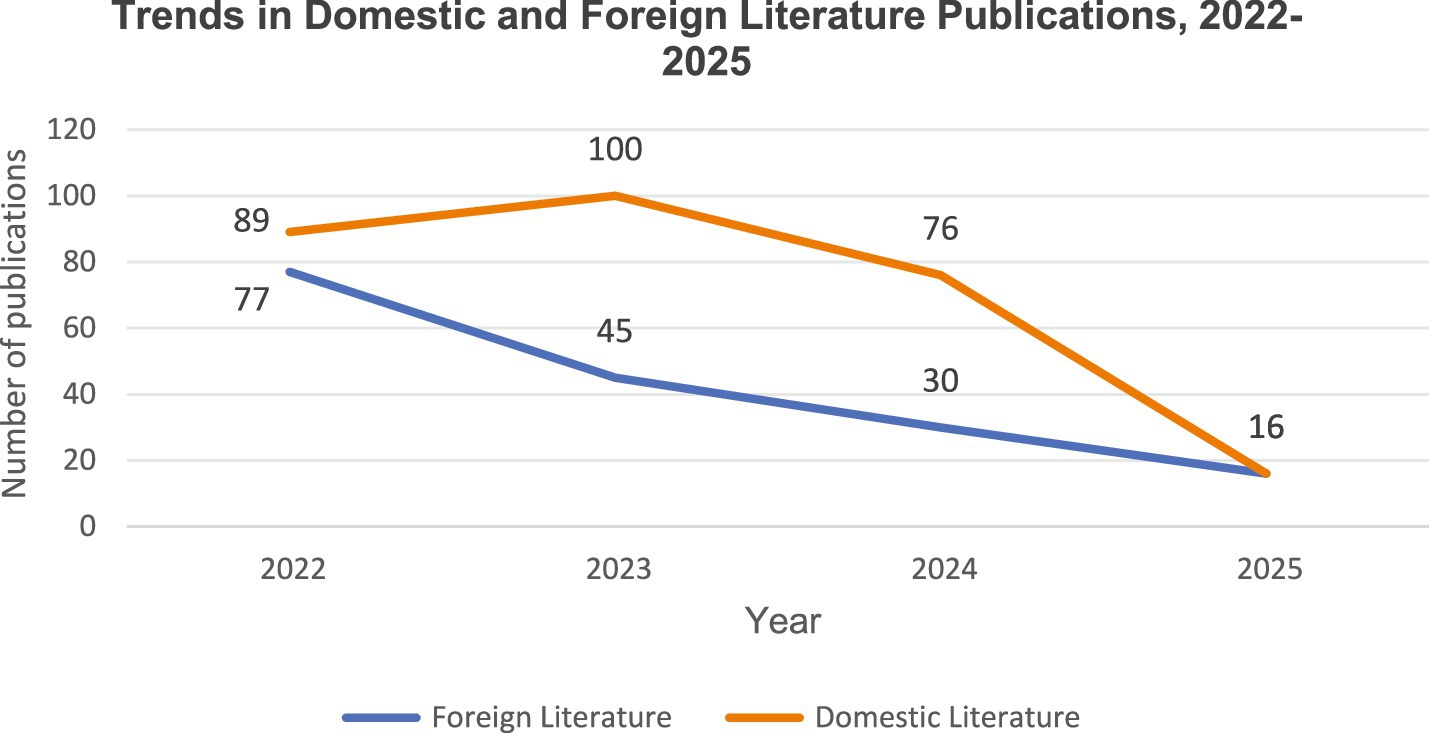
Figure 2. Annual trend chart of the number of articles published in domestic and foreign literature.
3.2 Analysis of national cooperation mapping
Using CiteSpace, we analyzed national publication volumes by selecting “Country” in the Node Types panel with a 1-year time interval. The resulting collaboration network (Figure 3) comprises 74 nodes and 101 links. In this visualization: the size of the nodes in the graph indicates the number of articles issued by the country (region); the color of the nodes indicates the cluster to which the country (region) belongs; the lines between the nodes indicate the existence of cooperative relationships, and the thicker the lines indicate the closer the relationship (10). As shown in Table 1, China contributed the highest number of publications, followed by the United States and Italy. In the international collaboration network, the China-Poland axis and the United States-Sweden axis both demonstrated close collaborative relationships, reflecting to some extent the synergistic advantages of these countries in terms of resource allocation and policy support. The development trends of these two collaborative axes illustrate the diversity of international cooperation models across different regional contexts. However, collaborations among most countries remain weak, indicating a need for gradually enhanced communication and deepened cooperation in the future.
3.3 Keyword co-occurrence analysis
Keyword co-occurrence analysis identifies high-frequency terms and their interrelationships by quantifying the co-occurrence frequency of keywords within literature during a specified research period, thereby revealing core research foci. Based on the concepts of citation coupling and co-citation in bibliometrics (11), the intrinsic connections between keywords appearing in the same literature are analyzed to reveal the research themes or directions in the field. The higher frequency of co-occurring words in the literature represents the closer relationship between them. Table 2 lists the top 10 foreign keywords in this field in terms of frequency, which are physical activity (117 times), childhood obesity (102 times), body mass index (41 times), weight loss (29 times), and body composition (29 times), pediatric obesity (25 times), insulin resistance (24 times), metabolic syndrome (19 times), lifestyle intervention (17 times), and physical fitness (16 times). Next, the keywords will be analyzed for co-occurrence, and the keyword co-occurrence network will be drawn to explore the strength of the connection between the keywords, which is shown in Figures 4, 5. Figures 4, 5 conduct co-occurrence analysis of the keywords, mapping keyword co-occurrence networks to explore the strength of connections between keywords. The data presented in Figures 3, 4 reveal that the main high-frequency keywords in the field of "obesity" not only include the core term "children," but also other important keywords such as "physical activity," "exercise," and "physical health." The keyword co-occurrence network demonstrates strong interconnectivity, indicating that research on childhood weight management has accumulated substantial findings over the years and has established itself as a significant area of study (Table 3).
3.4 Keyword cluster analysis
Keyword clustering analysis builds upon co-occurrence networks by employing algorithms (e.g., Log-Likelihood Ratio [LLR], Local Outlier Factor [LOF]) to synthesize keywords into numerically labeled clusters. Cluster IDs (e.g., #0, #1) follow size-based ordering, where smaller numbers indicate clusters containing more keywords. Each cluster label is determined by the keyword with the highest LLR value within that cluster, representing its core research theme. These clusters delineate the domain's knowledge structure and its evolution. In the visualization (Figure 6), distinct colors represent individual clusters, with keywords within each color range belonging to the corresponding thematic group (11). Based on keyword co-occurrence, this study conducted a clustering analysis of keywords and identified a total of 7 clusters, represented by irregular squares, namely: "physical fitness" (#0), "exercise intervention" (#1), "insulin resistance marker" (#2), "pediatric non-alcoholic fatty liver disease" (#3), "pediatric non-alcoholic fatty liver disease" (#4), "allergic diseases" (#5), and "physical activity intervention" (#6). As shown in Figure 5, the keyword co-occurrence map of research on childhood weight management generated 7 clusters. A modularity Q value of 0.7625 (>0.5) and a mean silhouette S value of 0.9086 (>0.7) indicate that the structure of the cluster analysis is significant. Furthermore, the figure highlights substantial overlap among clusters #2, #4, and #5, suggesting the presence of many shared keywords across these three clusters. "Allergic diseases" serves as an important bridge connecting cluster #2 "insulin resistance marker" and cluster #4 "pediatric non-alcoholic fatty liver disease". Cluster #2 has the smallest area, indicating it is composed of relatively few internal keywords.
3.5 Time line mapping analysis
In the timeline visualization (Figure 7), the abscissa represents the 2022–2025 timeline, progressing chronologically from left (early) to right (recent). The color gradient transitions from cool tones (blue/green) to warm tones (yellow/red) corresponding to temporal evolution. Annual vertical intervals demarcate research topic density fluctuations. The ordinate displays clustered research themes (e.g., #0, #1), with cluster labels positioned at the right margin (e.g., “mindfulness-based intervention,” “exercise intervention”). Node coloration indicates initial appearance time (cool: early; warm: recent). Nodes with purple outer rings denote high betweenness centrality (≥0.1), signifying pivotal knowledge bridges or disciplinary turning points. Inter-node connections represent co-occurrence/cocitation relationships, where line thickness correlates with association strength.
4 Discussion
4.1 Epidemiology of obesity and the urgency of weight management
Global obesity rates continue to escalate, demonstrating a trend toward earlier onset and stronger associations with chronic diseases. According to WHO data, the worldwide obese population has nearly tripled since 1975 (12). In China, approximately 20% of school-age children were overweight or obese in 2018, with projections indicating this prevalence may reach 31.8% by 2030 (13). Obesity-related medical expenditures now exceed 20% of total national healthcare costs, underscoring a critical public health burden. This crisis has elevated weight management from individual responsibility to national strategy. In 2024, China launched a three-year “National Weight Management Initiative,” mobilizing 16 governmental departments to create a supportive ecosystem for weight control. Evidence confirms that multisectoral collaboration enables sustainable obesity prevention through comprehensive, integrated approaches (14). Successful weight management research has moved from single calorie balancing to an era of multimodal precision interventions. International experience shows that effective management requires a four-dimensional linkage of policy and legislation, technological innovation, medical integration, and public education. Through the “Year of Weight Management,” China is exploring the prevention and control paths with local characteristics, but there is an urgent need to break through the bottlenecks of long-term effect maintenance and health economics evaluation. Future research should focus on biomarker mining, promotion of digital therapies, and cross-sectoral collaboration mechanisms, in order to realize the leap from “weight loss” to “whole-life health.”
4.2 Impact of overweight or obesity on children’s physical health
Overweight and obesity result from a chronic imbalance between energy intake and expenditure, which is characterized by an increased intake of energy-dense foods (e.g., fried foods, sugar-sweetened beverages) and physical inactivity resulting from a sedentary lifestyle. These dietary and inactivity patterns are strongly associated with environmental and social factors that promote the adoption of unhealthy behaviors, such as the intake of foods rich in sugars and fats or increased sedentary activity (15, 16). Childhood obesity has been associated with early markers of cardiovascular disease, insulin-resistant sleep disorders, increased risk of fractures, irregular menstruation in adolescent girls, and negative psychological effects (17, 18). In addition, obese children and adolescents are more likely to become obese adults and experience disability and premature death than their normal weight peers (19, 20). In the respiratory system, obese children have physiological limitations on chest wall expansion and diaphragmatic contraction due to excess abdominal adipose tissue, decreased chest compliance, and decreased lung compliance due to increased pulmonary blood flow and peripheral airway closure (21). Obesity decreases lung volume, increases airway resistance and affects lung capacity (22). Childhood obesity is an independent risk factor for obstructive sleep apnea (OSA), and the two conditions form a vicious cycle. Research hotspots focus on how intermittent hypoxia caused by OSA exacerbates insulin resistance and cardiovascular damage. The keyword timeline map analysis in Figure 6 shows that pediatric non-alcoholic fatty liver disease has become the leading cause of chronic liver disease in children. Related research hotspots concentrate on non-invasive diagnostic biomarkers (e.g., CK-18), the role of the gut-liver axis in pathogenesis, and the progression mechanisms from simple steatosis to steatohepatitis (23).
4.3 Effects of overweight or obesity on mental health aspects of children
Increasingly, boys and girls are experiencing negative emotions as a result of weight bullying Compared to their healthy weight peers, overweight or obese children are more likely to exhibit psychopathological manifestations, behavioral problems, and mood disorders (24), and they release negative emotions by avoiding physical education classes, consuming more food, and binge eating. Obese and overweight children are more likely to experience difficulties in peer relationships, and several studies have shown (25, 26) that such children have a higher probability of experiencing weight-related bullying than normal-weight children, and that such bullying is not moderated by gender, race, or socioeconomic background. At the same time, they are more likely to experience peer rejection and social isolation. Such rejection further exacerbates loneliness and internalized emotional problems (e.g., depression, anxiety), and obese children had significantly higher scores of low self-esteem than normal-weight children (p < 0.05), which was positively correlated with obesity (24). Obese children face weight bias from multiple environments, including from parents, obesity researchers, clinical settings (healthcare organizations), and schools. Parents not only show implicit bias against childhood obesity, but also implicit and explicit bias against obese children (27). This compromises their quality of life and promotes unhealthy behaviors that may exacerbate obesity, such as social isolation, decreased physical activity, and avoidance of medical care (28). Unfortunately, weight bias is widespread and tolerated in society, further extending the reach of its negative harm.
4.4 Analysis of research hotspots
In CiteSpace, research hotspots refer to the core themes that are common to the literature with intrinsic relevance within a specific time period, which are usually presented through keyword co-occurrence mapping and keyword clustering mapping. Keywords, as a condensation of the core content of the literature, focus on the core topics of the research.
4.4.1 Exercise interventions in children’s weight management
Nemet D et al. (29) showed that a weight management program through a multidisciplinary association contributed to a decrease in BMI and BMI percentile in obese children and improved children’s health. The data showed that water aerobic intervention not only reduced the weight of obese children but also improved their lung function. Wang C et al. (30) showed that physical activity was effective in decreasing body weight, heart rate (HR), systolic blood pressure (SBP), and diastolic blood pressure (DBP), and increasing - vo2max (maximal oxygen uptake) in obese children and adolescents. Brown’s study found that that children’s physical activity levels can be increased through family involvement (31). In addition, Pamungkas studied home-based interventions for the treatment and prevention of childhood obesity, where home management could increase the frequency of physical activity and reduce sedentary time (32). Aerobic training, inverse group training, or combined exercise training were mainly used in home exercise studies, and both types of exercise were effective in reducing total body fat in children (33). The main objectives of home exercise therapy are to reduce total and visceral fat content in children and parents, increase lean body mass, accelerate the consumption of excess energy in the body, maintain energy balance in the body, increase resting metabolism levels, increase lipid metabolism levels, and reduce the incidence of metabolic and cardiovascular complications (34).
4.4.2 Video games in weight management in children
In recent years, active video games have been proposed for obesity prevention and treatment as a potential tool to increase physical activity (35, 36). It requires physical activity to interact with on-screen images, reducing sedentary time and increasing metabolic equivalents through a technology based on body movement tracking (37). A study by Irandoust K et al. (38) demonstrated that the use of Xbox Kinect somatic gaming (39) as an intervention was effective in capitalizing on children’s interest in video games and significantly increased their participation in motivation for sports and exercise. This interest-driven intervention strategy not only enhanced exercise compliance, but also observed a significant improvement in first-second forceful expiratory volume of breath (FEV1) in the subject children, which in turn facilitated the achievement of weight control goals.
In the context of the information society, video games are increasingly recognized as a potential intervention tool for weight management. During the COVID-19 lockdowns, electronic sensor-based motion games were widely used to increase physical activity among children, effectively enhancing their daily activity levels during periods of home confinement (40).
5 Conclusion
This study reveals that childhood weight management research has evolved into a multidisciplinary field with clearly defined thematic clusters. Current research focuses on refining intervention strategies through structured physical activity programs, nutritional guidance, and family-centered behavioral modifications. The bibliometric analysis identifies seven major research clusters, with emerging emphasis on metabolic markers and personalized intervention approaches. Future research directions should prioritize: (1) Expanding the scope to include comorbidity profiles associated with childhood obesity; (2) Developing standardized biomarkers and objective assessment tools for early risk identification; (3) Accelerating the translation of evidence-based interventions into clinical practice through innovative delivery models; (4) Elucidating the physiological mechanisms linking childhood obesity to long-term health consequences. Establishing multidisciplinary collaborations, integrating advanced assessment technologies, strengthening mechanistic investigations, and implementing tailored intervention strategies represent critical steps toward advancing this field. The continuous evolution from fragmented approaches to integrated care models will ultimately enhance the efficacy of childhood weight management initiatives.
5.1 Research significance
The findings reveal that childhood weight management has formed a research architecture centered on physical activity interventions, metabolic markers, and specific disease clusters. Current studies demonstrate a transition from single-faceted behavioral interventions toward multidisciplinary coordinated care, with family involvement, personalized protocols, and long-term outcome evaluation emerging as critical research priorities.
(1) Deepening mechanistic investigations to elucidate the pathological relationships between obesity and childhood comorbidities such as metabolic abnormalities and non-alcoholic fatty liver disease.
(2) Developing integrated early-warning systems incorporating biomarkers, behavioral assessments, and environmental factors.
(3) Promoting innovative integrated intervention models operating within school-family-community settings.
(4) Enhancing comparative studies between Eastern and Western populations to establish localized guidelines tailored to the physiological characteristics of Chinese children.
We recommend establishing cross-disciplinary collaboration platforms, standardizing evaluation criteria, and strengthening the integration of evidence-based practice with real-world research to systematically advance childhood weight management from fragmented interventions toward a structured and precision-oriented prevention and control system.
5.2 Limitations
The data collection process focused solely on core Chinese and international databases. While these databases are widely utilized, they possess inherent limitations in terms of data coverage. Furthermore, a potential time lag exists between the publication of literature and its inclusion in these core databases. Newly published research may require a certain period before being indexed and searchable, which could introduce some bias into the findings. Therefore, future studies are recommended to incorporate a wider range of data sources to ensure comprehensiveness in data collection and minimize gaps in the research landscape.
Data availability statement
The original contributions presented in the study are included in the article/Supplementary material, further inquiries can be directed to the corresponding authors.
Author contributions
SY: Conceptualization, Data curation, Formal analysis, Software, Writing – original draft, Writing – review & editing. JW: Methodology, Supervision, Writing – original draft. HX: Supervision, Validation, Writing – review & editing.
Funding
The author(s) declare that no financial support was received for the research and/or publication of this article.
Conflict of interest
The authors declare that the research was conducted in the absence of any commercial or financial relationships that could be construed as a potential conflict of interest.
Generative AI statement
The authors declare that no Gen AI was used in the creation of this manuscript.
Any alternative text (alt text) provided alongside figures in this article has been generated by Frontiers with the support of artificial intelligence and reasonable efforts have been made to ensure accuracy, including review by the authors wherever possible. If you identify any issues, please contact us.
Publisher’s note
All claims expressed in this article are solely those of the authors and do not necessarily represent those of their affiliated organizations, or those of the publisher, the editors and the reviewers. Any product that may be evaluated in this article, or claim that may be made by its manufacturer, is not guaranteed or endorsed by the publisher.
Supplementary material
The Supplementary material for this article can be found online at: https://www.frontiersin.org/articles/10.3389/fpubh.2025.1665819/full#supplementary-material
References
1. Wang, J, Zhuang, P, Lin, B, Li, H, Zheng, J, Tang, W, et al. Gut microbiota profiling in obese children from southeastern China. BMC Pediatr. (2024) 24:193. doi: 10.1186/s12887-024-04668-4
2. Peng, W, Liu, S, Li, T, Wang, S, Sun, Z, Gou, B, et al. Interpretation of the world obesity report 2024 and implications for China. Chin J Prev Med. (2024) 25:388–94.
3. Stavridou, A, Kapsali, E, Panagouli, E, Thirios, A, Polychronis, K, Bacopoulou, F, et al. Obesity in children and adolescents during COVID-19 pandemic. Children. (2021) 8:135. doi: 10.3390/children8020135
4. Gallè, F, Sabella, EA, Ferracuti, S, De Giglio, O, Caggiano, G, Protano, C, et al. Sedentary behaviors and physical activity of Italian undergraduate students during lockdown at the time of COVID-19 pandemic. Int J Environ Res Public Health. (2020) 17:6171. doi: 10.3390/ijerph17176171
5. Choi, EJ, King, GKC, and Duerden, EG. Screen time in children and youth during the pandemic: a systematic review and Meta-analysis. Glob Pediatr. (2023) 6:100080. doi: 10.1016/j.gpeds.2023.100080
6. Anderson, PM, and Butcher, KF. Childhood obesity: trends and potential causes. Futur Child. (2006) 16:19–45. doi: 10.1353/foc.2006.0001
7. Chen, Y, Chen, CM, Liu, ZY, Hu, ZG, and Wang, XW. Methodological functions of cite space knowledge graph. Res Sci. (2015) 33:242–53. doi: 10.16192/j
8. Li, X. Visualization and analysis of domestic and international hospice research based on knowledge graph. Baoding: Hebei University (2020).
9. Pi, LF, Li, W, and Liu, Y. Analysis of research hotspots in the application of wearable devices in health management: A bibliometric analysis based on CiteSpace. Modern Nurse (Late Monthly). (2025) 32:21–27. doi: 10.19793/j
10. Wang, XJ, Liu, HY, Sun, LP, Min, H, and Gu, CY. Visualization analysis of research hotspots in domestic and international gestational weight management based on CiteSpace. Chin. J. Wom. Child Health. (2024) 15:33–40. doi: 10.19757/j
11. Dong, J. Visualization and comparative analysis of domestic and international research on music to relieve anxiety based on cite space. Qinhuangdao: Yanshan University (2024).
12. World Obesity Federation. (2024) World obesity atlas 2024 [EB/OL]. Available online at: https://data.worldo-besity.org/publications/?cat=22.
13. Chinese Expert Consensus on Obesity Prevention and Management[J]. J Xi’an Jiaotong University (Medical Sciences). (2022) 43:619–631.
14. Peng, W, Liu, S, Li, T, Wang, S, Sun, Z, Gou, B, et al. Interpretation of the world obesity report 2024 and its implications for China. Chin J Prev Med. (2024) 25:388–94. doi: 10.16506/j.1009-6639.2024.04.002
15. Kahan, LG, and Mehrza, R. Environmental factors related to the obesity epidemic. Obesity. (2020) 2020:117–39. doi: 10.1016/B978-0-12-818839-2.00010-7
16. Protano, C, Valeriani, F, Macedonio, A, Cammarota, F, Romano Spica, V, Orsi, GB, et al. Family-based social determinants and child health: a cross-sectional study. Pediatr Int. (2017) 59:201–8. doi: 10.1111/ped.13097
17. World Health Organization. (2021) Obesity and overweight fact sheets. Available online at: https://www.who.int/news-room/fact-sheets/detail/obesity-and-overweight (Accessed March 8, 2021).
18. Kansra, AR, Lakkunarajah, S, and Jay, MS. Childhood and adolescent obesity: a review. Front Pediatr. (2021) 8:581461. doi: 10.3389/fped.2020.581461
19. Shah, NM, and Kaltsakas, G. Respiratory complications of obesity: from early changes to respiratory failure. Breathe. (2023) 19:220263. doi: 10.1183/20734735.0263-2022
20. Truong, K, Park, S, Tsiros, MD, and Milne, N. Physiotherapy and related Management for Childhood Obesity: a systematic scoping review. PLoS One. (2021) 16:e0252572. doi: 10.1371/journal.pone.0252572
21. Gruber, W, Koop, J, Haegele, FA, Falkenberg, C, Dewey, S, Weisser, B, et al. Effects of an exercise intervention on exercise capacity in adults with cystic fibrosis: a quasi-experimental study comparing individuals treated with and without Elexacaftor/Tezacaftor/Ivacaftor. Pediatr Pulmonol. (2025) 60:76. doi: 10.1002/ppul.71076
22. Luhaste, V, Travis, F, Gorini, CA, Marković, G, and Schneider, RH. Effect of an innovative online Ayurveda program for detox and lifestyle on mental and physical health in home-based adults: a pilot study. J Integr Complement Med. (2025) 31:264–83. doi: 10.1089/jicm.2024.0489
23. Cho, KY. Lifestyle modifications result in alterations in the gut microbiota in obese children. BMC Microbiol. (2021) 21:10. doi: 10.1186/s12866-020-02002-3
24. Harrist, AW, Swindle, TM, Hubbs-Tait, L, Topham, GL, Shriver, LH, and Page, MC. The social and emotional lives of overweight, obese, and severely obese children. Child Dev. (2016) 87:1564–80. doi: 10.1111/cdev.12548
25. van Geel, M, Vedder, P, and Tanilon, J. Are overweight and obese youths more often bullied by their peers? A meta-analysis on the correlation between weight status and bullying. Int J Obes. (2014) 38:1263–7. doi: 10.1038/ijo.2014.117
26. Soares, S, Santos, AC, and Fraga, S. Adverse childhood experiences, bullying, inflammation and BMI in 10-year-old children: the biological embodiment. PLoS One. (2022) 17:e0273329. doi: 10.1371/journal.pone.0273329
27. Lydecker, JA, O'Brien, E, and Grilo, CM. Parents have both implicit and explicit biases against children with obesity. J Behav Med. (2018) 41:784–91. doi: 10.1007/s10865-018-9929-4
28. Pont, SJ, Puhl, R, Cook, SR, and Slusser, W. Stigma experienced by children and adolescents with obesity. Pediatrics. (2017) 140:e20173034. doi: 10.1542/peds.2017-3034
29. Nemet, D, Levi, L, Pantanowitz, M, and Eliakim, A. A combined nutritional-behavioral-physical activity intervention for the treatment of childhood obesity--a 7-year summary. J Pediatr Endocrinol Metab. (2014) 27:445–51. doi: 10.1515/jpem-2013-0349
30. Wang, C, Tian, Z, Hu, Y, and Luo, Q. Physical activity interventions for cardiopulmonary fitness in obese children and adolescents: a systematic review and meta-analysis. BMC Pediatr. (2023) 23:558. doi: 10.1186/s12887-023-04381-8
31. Markert, J, Herget, S, Petroff, D, Gausche, R, Grimm, A, Kiess, W, et al. Telephone-based adiposity prevention for families with overweight children (TAFF-study): one year outcome of a randomized, controlled trial. Int J Environ Res Public Health. (2014) 11:10327–44. doi: 10.3390/ijerph111010327
32. Cordellat, A, Padilla, B, Grattarola, P, García-Lucerga, C, Crehuá-Gaudiza, E, Núñez, F, et al. Multicomponent exercise training combined with nutritional counselling improves physical function, biochemical and anthropometric profiles in obese children: a pilot study. Nutrients. (2020) 12:2723. doi: 10.3390/nu12092723
33. Bonney, E, Ferguson, G, Burgess, T, and Smits-Engelsman, B. Benefits of activity-based interventions among female adolescents who are overweight and obese. Pediatr Phys Ther. (2019) 31:338–45. doi: 10.1097/PEP.0000000000000636
34. Yang, L, Liang, C, Yu, Y, Xiao, Q, Xi, M, and Tang, L. Family sports interventions for the treatment of obesity in childhood: a meta-analysis. J Health Popul Nutr. (2022) 41:40. doi: 10.1186/s41043-022-00317-7
35. Zeng, N, and Gao, Z. Exergaming and obesity in youth: current perspectives. Int J Gen Med. (2016) 9:275–84. doi: 10.2147/IJGM.S99025
36. Thivel, D, and O'Malley, G. Pediatric obesity: is there room for active video games in prevention or management? Pediatr Phys Ther. (2016) 28:368–70. doi: 10.1097/PEP.0000000000000297
37. Chen, H, and Sun, H. Effects of active videogame and sports, play, and active recreation for kids physical education on children's health-related fitness and enjoyment. Games Health J. (2017) 6:312–8. doi: 10.1089/g4h.2017.0001
38. Irandoust, K, Taheri, M, H'mida, C, Neto, GR, Trabelsi, K, Ammar, A, et al. Exergaming and aquatic exercises affect lung function and weight loss in obese children. Int J Sports Med. (2021) 42:566–72. doi: 10.1055/a-1289-9307
39. Levac, D, McCormick, A, Levin, MF, Brien, M, Mills, R, Miller, E, et al. Active video gaming for children with cerebral palsy: does a clinic-based virtual reality component offer an additive benefit? A pilot study. Phys Occup Ther Pediatr. (2018) 38:74–87. doi: 10.1080/01942638.2017.1287810
Keywords: children, weight management, CiteSpace, visualization analysis, bibliometrics
Citation: Yang S, Wang J and Xu H (2025) Global research hotpots on child weight management: visualized analysis based on CiteSpace. Front. Public Health. 13:1665819. doi: 10.3389/fpubh.2025.1665819
Edited by:
Shungen Huang, Children's Hospital of Soochow University, ChinaReviewed by:
Niken Bayu Argaheni, Sebelas Maret University, IndonesiaYohanis Ndapa Deda, Universitas Timor, Indonesia
Copyright © 2025 Yang, Wang and Xu. This is an open-access article distributed under the terms of the Creative Commons Attribution License (CC BY). The use, distribution or reproduction in other forums is permitted, provided the original author(s) and the copyright owner(s) are credited and that the original publication in this journal is cited, in accordance with accepted academic practice. No use, distribution or reproduction is permitted which does not comply with these terms.
*Correspondence: Siyi Yang, MTg3NjgzOTUzMjZAMTYzLmNvbQ==; Jing Wang, MTU3MjM2NTM5NkBxcS5jb20=
 Siyi Yang
Siyi Yang Jing Wang*
Jing Wang*